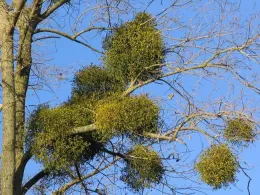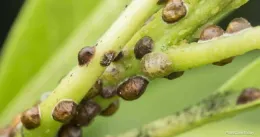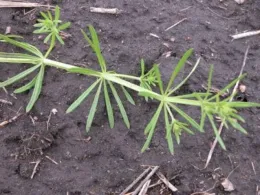Broadleaf mistletoe (Phoradendron macrophyllum)

Leafy mistletoes have green stems with thick leaves that are nearly oval in shape. Plants often develop a rounded form up to 2 feet or more in diameter. The small, sticky, whitish berries are produced from October to December. Evergreen clumps of mistletoe are readily observed on deciduous trees in winter when leaves are off the trees. Mistletoe plants are either female (produce berries) or male (produce only pollen).
For good control, remove branches at least 1 foot below the point of mistletoe attachment. Simply cutting off mistletoe from trees can reduce spread, but it won't provide control. If it's not possible to remove the infested trunk or a major branch, prune off the mistletoe and wrap the infested area of the tree with sturdy black polyethylene plastic secured with twine or tape to exclude light. Leave on for up to two years until the mistletoe dies, replacing plastic that becomes torn. For more information and other control suggestions, click here.
Scales
Scales are sucking insects that insert their tiny, straw-like mouthparts into bark, fruit, or leaves, mostly on trees, shrubs, and other perennial plants. Some scales can seriously damage their host, while other species do no apparent damage to

Some scale species, when abundant, weaken a plant and cause it to grow slowly. Infested plants appear water stressed, leaves turn yellow and may drop prematurely, and plant parts that remain heavily infested may die. The dead brownish leaves may remain on scale-killed branches, giving plants a scorched appearance. If the scale produces honeydew, this sticky excrement, sooty mold, and the ants attracted to honeydew can annoy people even when scales are not harming the plant.
Many species are usually well controlled by beneficial predators and parasites (natural enemies). A well-timed and thorough spray of horticultural (narrow-range) oil during the dormant season, or soon after scale crawlers are active in late winter to early summer, can provide good control of most species of scale. Because ants attack and feed on scale parasites and predators, control ants if they are tending scales. For more information and other control suggestions, click here.
Catchweed bedstraw
Catchweed bedstraw, Galium aparine, is an annual weed belonging to the Madder (Rubiaceae) family, can be found throughout most of the world. The species name “aparine” comes from a Latin word meaning “to seize,” which is very appropriate considering the clinging nature of this weed.


